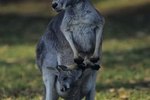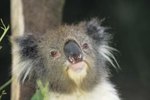Kangaroos are the largest members of the order Marsupialia whose members gestate their young in their pouches. A kangaroo joey--or baby--crawls from the mother's birth canal into her pouch when it is no bigger than a peanut, then spends much of its next nine months comfortably ensconced, nursing at will.
Function
A kangaroo's pouch functions in the same way as other mammal's wombs, protecting the developing baby and providing nourishment. Because the joey cannot at first keep hold of a teat on its own, the nipple expands within its mouth, making it difficult for the joey to let go. This characteristic and the security of the pouch ensure the baby will get essential nourishment.
As anyone who has ever changed a diaper knows, nursing babies must eliminate waste, too. The joey urinates and defecates wherever it happens to be, which for the first part of its life is in the mother's pouch. The mother kangaroo cleans her pouch and grooms her baby frequently, consuming the baby's waste.
Types

Red and gray kangaroos are common types of a group that includes nearly 50 kinds of kangaroos. Their young gestates inside the females' bodies for between 30 and 36 days. When she is ready to give birth, the mother cleans out her pouch, eating any remaining waste from the previous joey, to make it ready for the new arrival. Tree kangaroos give birth after a gestation period of around 44 days. The joey will stay in the pouch, attached to a teat, for 10 months before it ventures out.
Time Frame

A kangaroo joey remains attached to its mother's teat for 120 to 235 days depending on the species. Meanwhile, the mother may mate again, and if she conceives, she must put the new embryo on hold until she has a vacancy in her pouch. Kangaroos have a unique ability to save an embryo in suspended animation, so to speak, until the older sibling is able to leave the pouch. When the new baby is installed, the older joey can still nurse from another of its mother's teats that produce milk formulated for an older offspring. The emancipated joey begins to eat grass as well and eliminates waste just as adults do.
Benefits
When a kangaroo joey first crawls into its mother's pouch, and for several months thereafter, it is hairless, helpless and has its eyes closed. The pouch keeps the infant in contact with a food source and provides protection, which allows the infant time to grow. Just like a human embryo, the joey goes wherever its mother does, surrounded and cushioned by her body. The human mother processes her fetus' urine internally via the amniotic fluid. The kangaroo just has to take care of it a little differently because of to its marsupial nature.
Geography

Marsupial mammals are native almost exclusively to Australia. Such species as wombats, koalas and wallabies all have pouches where they carry their young. Because Australia is independent geographically from other continents, most marsupials, with the exception of the American opossum, did not develop in any other part of the world.
References
Photo Credits
-
Australian Kangaroo with Joey in pouch image by PoveyCam from Fotolia.com
Writer Bio
I have an MFA degree in Creative Writing and am a published poet who has received several poetry awards. I have established a reputation as an environmental activist, both through the group I co-founded -- see alternativeone.org -- and through a series of op-ed pieces in Montana newspapers. I have written extensively on alternative energy, recycling and endangered species.




